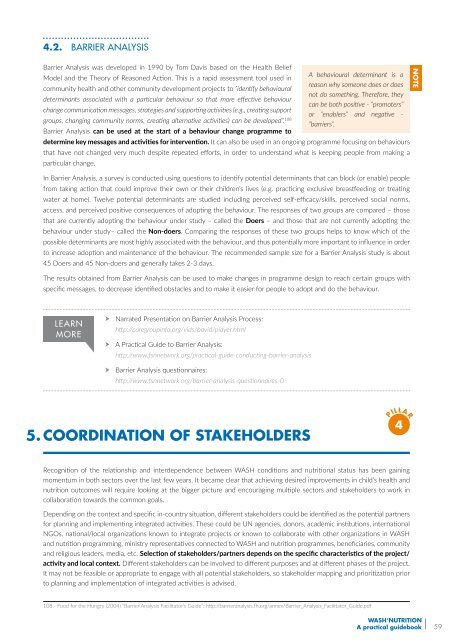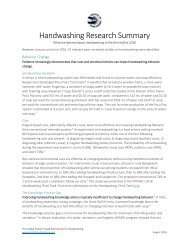WASH’ Nutrition
manuel_wash_nutrition_online
manuel_wash_nutrition_online
Create successful ePaper yourself
Turn your PDF publications into a flip-book with our unique Google optimized e-Paper software.
4.2. Barrier analysis<br />
Barrier Analysis was developed in 1990 by Tom Davis based on the Health Belief<br />
Model and the Theory of Reasoned Action. This is a rapid assessment tool used in<br />
A behavioural determinant is a<br />
reason why someone does or does<br />
community health and other community development projects to ”identify behavioural<br />
not do something. Therefore, they<br />
determinants associated with a particular behaviour so that more effective behaviour<br />
can be both positive - “promoters”<br />
change communication messages, strategies and supporting activities (e.g., creating support<br />
or “enablers” and negative -<br />
groups, changing community norms, creating alternative activities) can be developed”. 108<br />
“barriers”.<br />
Barrier Analysis can be used at the start of a behaviour change programme to<br />
determine key messages and activities for intervention. It can also be used in an ongoing programme focusing on behaviours<br />
that have not changed very much despite repeated efforts, in order to understand what is keeping people from making a<br />
particular change.<br />
In Barrier Analysis, a survey is conducted using questions to identify potential determinants that can block (or enable) people<br />
from taking action that could improve their own or their children’s lives (e.g. practicing exclusive breastfeeding or treating<br />
water at home). Twelve potential determinants are studied including perceived self-efficacy/skills, perceived social norms,<br />
access, and perceived positive consequences of adopting the behaviour. The responses of two groups are compared – those<br />
that are currently adopting the behaviour under study – called the Doers – and those that are not currently adopting the<br />
behaviour under study– called the Non-doers. Comparing the responses of these two groups helps to know which of the<br />
possible determinants are most highly associated with the behaviour, and thus potentially more important to influence in order<br />
to increase adoption and maintenance of the behaviour. The recommended sample size for a Barrier Analysis study is about<br />
45 Doers and 45 Non-doers and generally takes 2-3 days.<br />
The results obtained from Barrier Analysis can be used to make changes in programme design to reach certain groups with<br />
specific messages, to decrease identified obstacles and to make it easier for people to adopt and do the behaviour.<br />
NOTE<br />
LEARN<br />
MORE<br />
Narrated Presentation on Barrier Analysis Process:<br />
http://caregroupinfo.org/vids/bavid/player.html<br />
A Practical Guide to Barrier Analysis:<br />
http://www.fsnnetwork.org/practical-guide-conducting-barrier-analysis<br />
Barrier Analysis questionnaires:<br />
http://www.fsnnetwork.org/barrier-analysis-questionnaires-0<br />
5. Coordination of stakeholders<br />
PILLAR<br />
4<br />
Recognition of the relationship and interdependence between WASH conditions and nutritional status has been gaining<br />
momentum in both sectors over the last few years. It became clear that achieving desired improvements in child’s health and<br />
nutrition outcomes will require looking at the bigger picture and encouraging multiple sectors and stakeholders to work in<br />
collaboration towards the common goals.<br />
Depending on the context and specific in-country situation, different stakeholders could be identified as the potential partners<br />
for planning and implementing integrated activities. These could be UN agencies, donors, academic institutions, international<br />
NGOs, national/local organizations known to integrate projects or known to collaborate with other organizations in WASH<br />
and nutrition programming, ministry representatives connected to WASH and nutrition programmes, beneficiaries, community<br />
and religious leaders, media, etc. Selection of stakeholders/partners depends on the specific characteristics of the project/<br />
activity and local context. Different stakeholders can be involved to different purposes and at different phases of the project.<br />
It may not be feasible or appropriate to engage with all potential stakeholders, so stakeholder mapping and prioritization prior<br />
to planning and implementation of integrated activities is advised.<br />
108 - Food for the Hungry (2004) “Barrier Analysis Facilitator’s Guide”: http://barrieranalysis.fh.org/annex/Barrier_Analysis_Facilitator_Guide.pdf<br />
<strong>WASH’</strong><strong>Nutrition</strong><br />
A practical guidebook<br />
59



